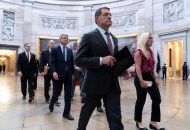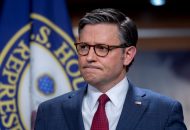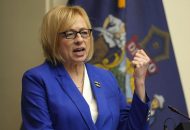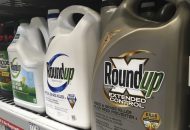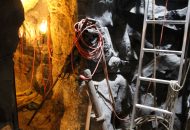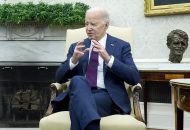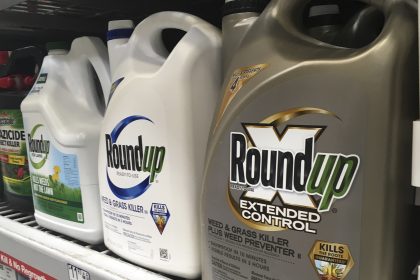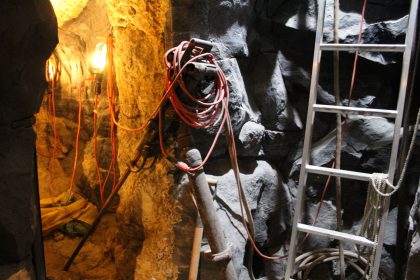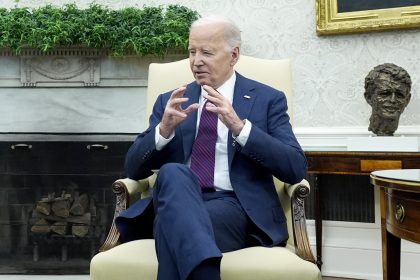Coronavirus Crisis Seeds Chaos in Washington and on Wall Street

NEW YORK — In the 24 hours after President Donald Trump assured Americans that the response to the coronavirus was well in hand, signs of disorder began to emerge from Washington to Wall Street.
The Trump administration was accused of not providing protective gear or training to workers who helped evacuate Americans from the outbreak’s origin in China. Diagnostic kits distributed to cities and states have failed to work, limiting the ability of front-line health workers to search for the virus. In California, the first patient without ties to a known case was diagnosed, raising fears that the pathogen is already quietly circulating in parts of the country.
On Thursday evening, Trump commented on the situation from the White House, calling the U.S. response to the virus so far “an incredible achievement.”
“I gave a press conference yesterday that was really a very good press conference,” Trump said at the event, billed as a discussion of his administration’s success in empowering members of the African American community. “Basically it was a calming press conference, it was a conference to say we’re doing well.”
That was not the perception on Wall Street, where the U.S. stock market tumbled into a correction, more than 10% below recent highs, capping off one of the worst runs for equities since the darkest days of the financial crisis.
The Dow Jones Industrial Average had its worst single-day point slide ever, sinking 1,190.95 points, or 4.4%, while the S&P 500 index tumbled 4.4% to its lowest since October. Bond yields cratered as investors sought the safe have of U.S. Treasuries, and commodity prices plummeted, with oil prices falling well below $50 a barrel. Analysts at Goldman Sachs Group Inc. slashed their outlook for U.S. companies’ profit growth to zero for the year.
The stretch that began with Trump’s news conference Wednesday night and ended with a whistleblower complaint accusing the government of failing to protect its own employees from the virus amounted to a chaotic chain of events that have gutted the perception that the crisis will have little impact on the U.S. Even if the number of U.S. cases stays small — unlikely, according to health experts — the confidence of the public and investors appears rattled.
“This is possibly the worst thing I’ve ever seen in my career,” Scott Minerd, the chief investment officer of Guggenheim Partners, where he oversees about $215 billion, said in an interview on Bloomberg Television. “I’ve been through a lot. I’ve been through the stock market crash in ’87, I went through the financial crisis. This has the potential to reel into something extremely serious.”
Disease experts feel no better about the future of the outbreak, which they have warned has the potential to disrupt daily life as it has in other areas with epidemics. Mike Osterholm, director of the Center for Infectious Disease Research and Policy at the University of Minnesota’s medical school, said he worries the California case is the tip of an iceberg.
“Transmission is going on,” Osterholm said in a telephone interview. “It’s not going to be different than in the Middle East, the European Union or Asia.”
Trump’s White House news conference Wednesday night began with a reassurance: “Because of all we’ve done the risk to the American people remains very low.”
That’s true. Experts inside and outside the government have put the mortality rate of the virus at around 2%. For individuals, it’s unlikely that a case will be serious or deadly. The worry is that it spreads widely, infecting enough people to rack up a serious body count, and that the measures needed to stop it stagger the economy as they briefly did in China.
Even as the president was speaking Wednesday evening, the Centers for Disease Control and Prevention was preparing to release a statement acknowledging a worrying first: a U.S. patient had been diagnosed with the coronavirus, but the person had no travel history to China or contact with other known patients. It was a sign of what’s known as community spread — human-to-human transmission of an infection outside the closely watched group of people that health workers have seen as most at risk.
Trump had been briefed on the new case before he spoke to reporters, and was told it wasn’t linked to other outbreaks, according to people familiar with the matter. But with few details, he made only a passing reference to what would explode into a major story later that evening.
The news conference ended with a concerning sign about the efforts to coordinate the response. Trump named Vice President Mike Pence to lead the federal response to the coronavirus, putting him on top of a task force led by Health and Human Services Secretary Alex Azar. As Trump left the room, Azar answered a reporter’s question about who was in charge: “I’m still chairman of the task force,” Azar said.
In California late that evening, new details were emerging about the patient. The woman had been transferred from a small local hospital near one of the military bases where Americans from China and Japan have been evacuated. She arrived after already having been put on a ventilator, meaning her disease was bad enough that she could no longer breathe on her own. And the patient had been gravely ill for at least a week — but gone undiagnosed — potentially exposing health care workers at the two facilities where she was cared for.
To find mystery patients like the California woman, the U.S. has said it will rely on a network of city and state public health departments. On Feb. 5, the CDC said it would send test kits to 200 labs around the country so they could quickly test and diagnose cases of the coronavirus. Federal officials also activated a disease surveillance network that’s typically used to track seasonal influenza to test potential patients for the coronavirus.
The test kits use swabs taken from a patient’s nose and throat, and analyze the sample for genetic signs of the virus. But the kits sent out by the CDC have failed to work, in many cases. Three weeks after first shipping out the test kits, only about 40 labs have been able to use them — and only after the test process was modified in a way that makes it less certain of getting a correct diagnosis.
That’s left some major areas like New York City unable to test locally for the virus, and created mounting complaints about the faulty kits.
“Testing for coronavirus is not available yet in New York City,” said Stephanie Buhle, spokeswoman for the New York City Department of Health and Mental Hygiene, the largest U.S. municipal public health agency. “The kits that were sent to us have demonstrated performance issues and cannot be relied upon to provide an accurate result.”
In Florida, Miami-Dade County has been told it won’t have supplies to do its own tests for two to three weeks.
“It’s the largest county in the state of Florida with a large international airport. We should have kits,” Miami-Dade Mayor Carlos Gimenez said Thursday. “It takes two days to get the results back when in fact we could have it back in five or six hours.”
The CDC took steps to broaden surveillance Thursday, saying it would greatly expand the number of people checked for the virus. Under new criteria, anyone with symptoms plus a recent travel history to China, Iran, Italy, Japan or South Korea within the past 14 days will be screened. So too will patients who have unexplained, severe lower-respiratory illnesses that require hospitalization.
“I think it’s been handled poorly at the federal level,” said Art Caplan, a professor of bioethics at New York University. “Everyone I know is talking about it. They aren’t panicked, but they are worried.”
By mid-afternoon, what appeared to be another down day in the market began to turn into a rout. At 2:23 p.m. in New York, the S&P 500 was down 2.5%. Over the next hour-and-a-half, the slide accelerated, ending the day down 4.4% for the worst one-day loss in eight years. The six-day, 10% decline was the index’s fastest correction in history.
As the markets fell, Pence made clear that he, not Azar, was leading the response.
“I’m leading the task force,” Pence said at a meeting on the virus at the health department’s headquarters in Washington. “We’ll continue to rely on the secretary’s role as chairman of the task force and the leader of health and human services.”
Twenty minutes after the market closed, The Washington Post put up a report further calling into question the administration’s handling of the outbreak. A whistleblower accused the Department of Health and Human Services of failing to give protective equipment or training to more than a dozen federal workers who helped receive Americans evacuated from Wuhan, China — where the outbreak began and has sickened tens of thousands of people.
“This matter concerns HHS’s response to the coronavirus, and its failure to protect its employees and potentially the public,” the whistleblower’s lawyer, Ari Wilkenfeld, said in a statement. A Trump administration official testifying at a congressional hearing disputed the idea that workers weren’t given the necessary training and equipment.
That evening, at the White House, Trump continued to reassure Americans. “It’s working out very professionally,” he said.
———
With assistance from Timothy Annett, Joe Weisenthal, Josh Wingrove, Michelle Fay Cortez, Robert Langreth and Jordan Fabian.
———
©2020 Bloomberg News
Visit Bloomberg News at www.bloomberg.com
Distributed by Tribune Content Agency, LLC.










